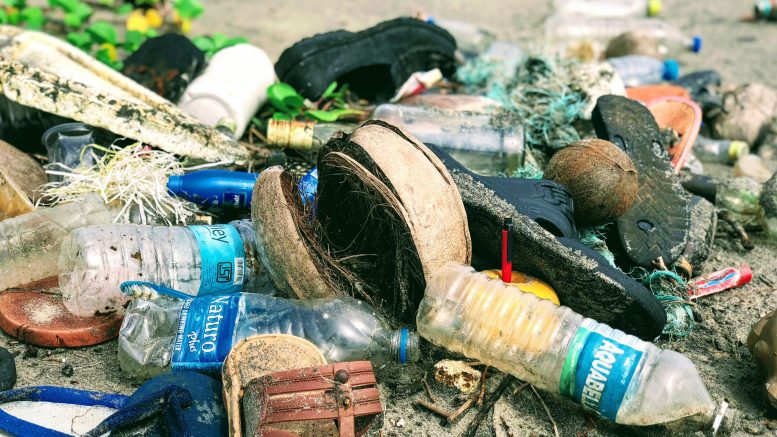SN&R recently sat down with California State Senator Ben Allen, who represents the 24th Senate District, which includes the Santa Monica Mountains and the South Bay. Allen is chair of the Senate Environmental Quality Committee. In an extensive interview, Allen told News & Review about his ongoing efforts to combat plastic pollution, hazardous household waste and other toxic contaminations in California’s environment.
As the chair of the Senate Environmental Quality Committee, you’ve taken a leadership role in rethinking environmental policy in California, including legislation on plastic pollution, greenhouse gas emissions, electric vehicles, marine life protection, and climate accountability. These bills are helping to lower emissions and develop a circular economy in California where producers are paying for the end-life of their products. Can you talk about why that’s critically important?
Manufacturers are not required to factor in the cost of end-of-life management for their products. They make cheap goods and sell them cheaply to increase their profit margins, and Californians are too often left footing the bill, which costs our state—at every level—untold millions annually. Those goods end up polluting the environment, which impacts everything from climate change to public health to plants and animals. We’re talking about air pollution causing asthma, hospital visits, and lost work and school days.
The folks that produce these products have no skin in the game when it comes to the end-use of their products. Instead, our cities and local governments are left facing impossible dilemmas to balance their budgets while covering increasing waste management costs to get rid of this extra waste. That’s something I think a lot of regular folks just aren’t aware of.
At the end of the day, what we’re trying to do is ask these producers to take some accountability, to play a role in helping ensure their products are disposed of responsibly or recycled into new products. They’re the ones who have the most control over how these products are designed and who best understand their markets, so passing that responsibility off on the consumers, to cities, and to local governments is misplaced and unfair. That’s what the concept of extended producer responsibility is all about.
Do the multiple bills including plastic packaging, batteries, paint, etc., end up having a cumulative impact that will change manufacturing and packaging processes to significantly reduce pollution and greenhouse gases?
Absolutely. We’re already starting to see a change in how manufacturers bring their products to the market, such as changes in design for recyclability, packaging, and reuse options. The idea is that there’s a greater market for using products like paint, for example, resulting from California’s Paint Care Program, which is a similarly conceived idea.
It’s ultimately about ensuring that producers start to factor end-use into consideration when they’re making their products. We’ve heard from entrepreneurs who’ve been producing more sustainable, environmentally friendly products over the years who are finally getting calls back from producers and distributors. The Walmarts, Targets, Best Buys, and Home Depots of the world are suddenly interested in these innovations because they know there’s this real push toward greater circularity, when before they were concerned with bulk and profit margins.
The cumulative impact is that if there are changes to manufacturing and packaging in the beginning, then there won’t be as much waste to deal with at the end.

The plastic bill (SB 54) which calls for producers to create organizations that will ensure their products and packaging meet aggressive rates and dates for waste reduction, recyclability, re-usability, and compostability. What is your sense of how it is being implemented?
The process of implementation is underway, and I’m really heartened to see the robust stakeholder participation in the process. We’ve been getting a lot of outreach from sustainable companies that want to be part of the conversation and are putting their products forward for consideration, which is fantastic. We’re also starting to see greater research and development dollars going toward the conceptualization, development, and scaling of the next generation of more environmentally friendly products and packaging. SB 54 was a massive bill … It’s a huge undertaking and the draft regulations are very detailed. We’re carefully working through the document to ensure that all the hard work that we and our partners put in is realized as the program rolls out. We expect to learn a lot along the way. We’re watching other states, like Colorado and Oregon, and offering guidance to those who are trying to move similar bills. We want to make sure that they can learn from our experience. We can also have programs in place that will make it easier for all the players to meld the models. We’re watching and in close touch with CalRecycle. There’s real interest at the federal level with the administration to try to see what we can do to expand this model nationally, and there’s also international engagement in the process because other countries are seeing this as the next step model that will help to drive where the US goes.
Now lets talk about the household hazardous waste bill (SB 1143), which requires producers of the most toxic consumer products to fund and ensure convenient access to a system for the safe collection, transportation, and disposal of HHW, shifting the cost burden of managing disposal from local jurisdictions and ratepayers to the producers. Why did you introduce this legislation?
A lot of the same basic forces and factors are at play on this issue as with plastics and these other bills we’ve worked on … it’s about extended producer responsibility. Household hazardous waste creates a lot of costs for local cities and counties. There’s a lot of confusion because consumers don’t know what’s considered household hazardous waste or how to properly manage what’s toxic. There’s very few convenient opportunities to properly dispose of damaged materials. Even for those who are aware and want to do the right thing, it’s a hassle, so a lot of stuff is just thrown into the trash.
SB 1143 sets up an extended producer responsibility program, similar in many ways to SB 54. It’s about shifting the cost burden so the producers are in the driver’s seat to help us solve this problem, both logistically and financially. There’s an education and outreach component. This is critically important because too often people don’t know where to take their household hazardous waste. There’s area safety concern since this is toxic material in people’s homes. We want to require producers to fund convenient options so there’s greater access to drop off. And, there’s going to be a fee-based approach to incentivize better alternatives. Producers pay based on the toxicity of the material.
There is a general agreement that the vast majority of household hazardous waste ends up in our water or landfills, and that manufacturers are paying very little for the damage they’re doing. How does the bill address those issues?
The bill is focused on reducing the amount of toxins in household hazardous waste, moving to alternative methods, and developing procedures for the collection and proper disposal of that waste. First of all, it forces the producers to have more convenient options for pickup and drop off of these items. It creates an incentive structure for them to move toward lower-toxicity products and creates a model whereby they will be responsible for the end-life of their products.
A producer responsibility organization is established under the bill, and the producers pay for the system. We’re trying to use market mechanisms to really push the producers toward lower toxicity, easier disposal, and easier products to recycle and reuse. It’s all about engaging the industry to make improvements.
Many municipalities currently collect only a very small percent of household hazardous waste and say they have no additional money to expand their programs. Do you have a sense of what they are currently spending and what it would cost to have a more robust program funded by producers?
For one example, there’s currently a $5 million, annual, state-wide fund for the grant program. But Sonoma County alone, which is a relatively small county, is now being forced to create a new premium plant to deal with hazardous waste that’s going to cost them from $13 to $16 million. That’s just one county dealing with a real problem, right? So, the available resources are dwarfed by the need, and we want producers to help with that.
How can people help make this happen?
Every step of the way, this has been something driven by our cities, localities, environmental groups, and people who’ve come forward and expressed their interest, engagement, and passion for this. We need people to be aware of this problem and help us get the word out an reach out to their legislators. People need to bring this up at town hall meetings, to call their legislators, and let them know how much they want to see progress made on this issue.



Be the first to comment on "State Senator Ben Allen discusses new efforts to handle household hazardous waste, other eco-threats in California "